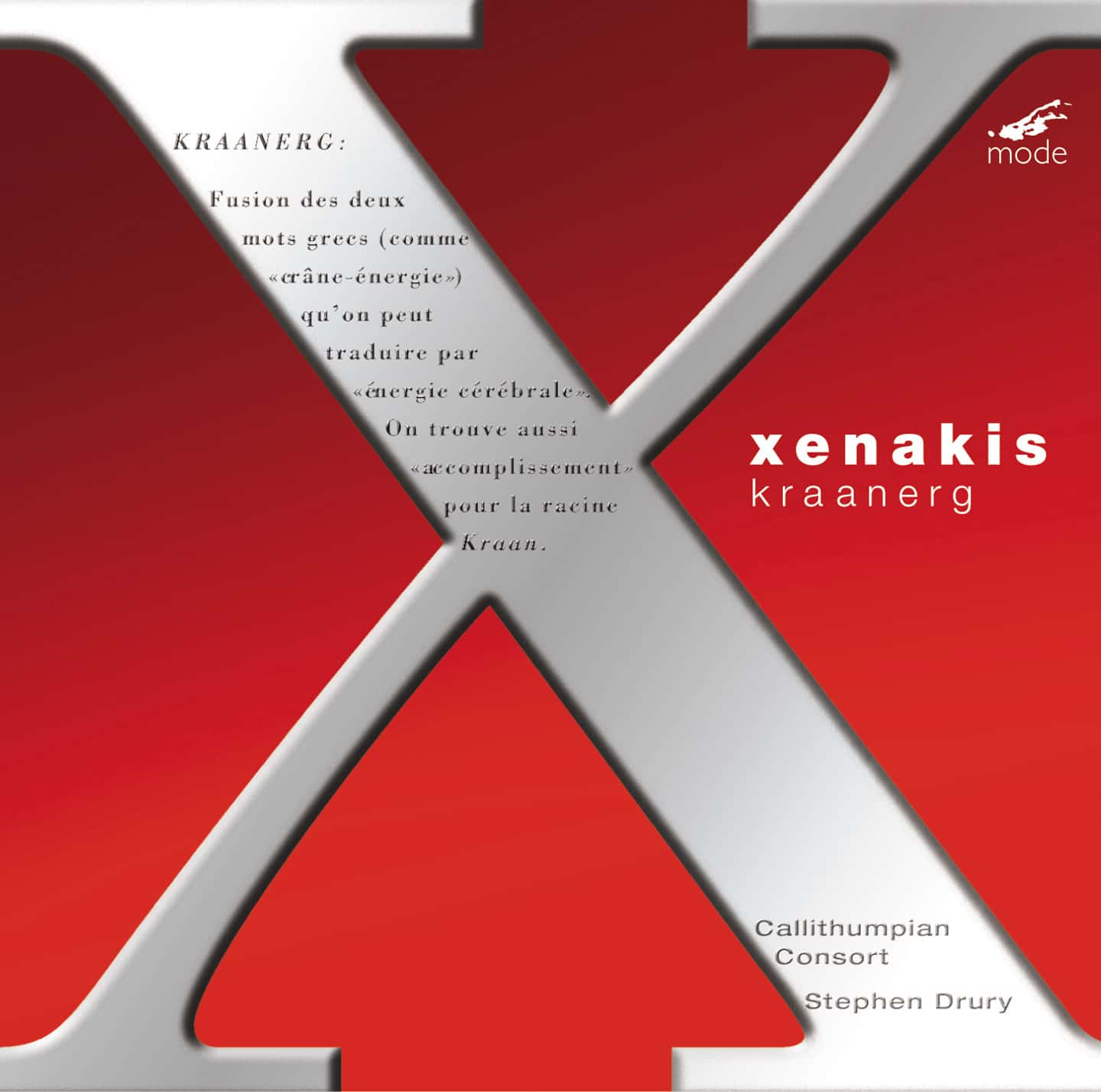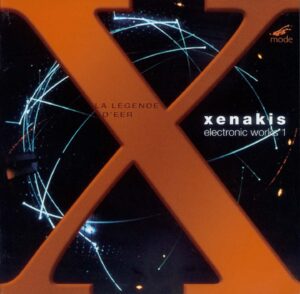Xenakis Edition 8-Kraanerg - CD
Callithumpian Consort ; Stephen Drury, conductor. Recorded in Mar. 7, 2006, Jordan Hall, New England Conservatory, Boston. Previously released as a compact disc.
Kraanerg (1968) (77:18)
for 23 instruments and 4-channel tape
Callithumpian Consort
Stephen Drury, conductor
First recording with restored analog tape
“It is a wonderful piece of music, enthralling, and one that grips the mind and the heart…(it) is one of the major ballet scores of the century”.
– Clive Barnes, New York Times, 1968
Kraanerg is one of Xenakis’ most popular – and infamous – works. A visceral and highly charged score for woodwinds, brass, and strings along with quadrophonic tape. The title, Kraanerg, is a composite of two Greek words: “kraan”, meaning to perfect, to accomplish; and “erg”, signifying energy.
Commissioned for the gala opening of the National Arts Centre (NAC) in Ottawa, Canada in 1968, Kraanerg originally was the score to a ballet choreographed by Roland Petit with “op-art” sets by Victor Vasarely.
According to Xenakis’ program notes, the title also referred to the “current youth movements” – 1968 was a significant year in modern social history – and to his utopian vision of the upcoming “biological struggle between generations unfurling all over the planet, destroying existing political, social, urban, scientific, artistic and ideological frameworks on a scale never before attempted by humanity.” This powerful statement can be felt in the music.
The dramatic 4-channel tape is derived from a recording of the orchestra, transformed and distorted. Its sonic textures kaleidoscopically expand the range of expression while at the same time remaining connected to the instrumental material.
The 4-channel tape has been restored for this release from high-resolution transfers of the analog masters by German electronic composer Daniel Teige – revealing greater details in the texture and a wider dynamic range than previously heard on any Kraanerg recording.
96khz/24-bit high resolution recording.
Liner notes by composer James Harley.
Available as CD (MOD-CD-196) and surround-sound video DVD (MOD-DV-D196).
SPECIAL DVD FEATURES
- First surround-sound release of Kraanerg.
- Mode returned to the 4-track analog tapes and remastered them for this release – revealing previously unheard detail, clarity and extended low-end frequencies.
- First recording to strictly respect the silences indicated in Xenakis’ score.
- Interview on Kraanerg’s history featuring Xenakis expert James Harley with Gerard Pape (director of Xenakis’ CCMIX studio 1991-2008), Françoise Xenakis (the composer’s wife, author and media personality), and Veronica Tennant (a lead dancer in the ballet’s premiere). [26 minutes]
- Additional documentary on Kraanerg’s tape with German electronic composer Daniel Teige, with musical examples. [12 minutes]
Reviews
Iannis Xenakis
Kraanerg
Mode 196 (CD & DVD)
Kraanerg stands as the longest stretch of non-stop music Xenakis ever composed, and has historically been his most problematic piece. The backstory is that Xenakis was approached to create a ballet score for the inauguration of Ottowa’s National Arts Centre in 1969. Despite a new university post and work on another commission, Xenakis accepted the challenge to produce a 75 minute score in six months. The director of the first production infuriated him by slamming an interval in the middle of his fastidious architecture; most contemporary critics agreed that the music was superb, but regretted the stilted staging.
All these decades later a paradox hangs awkwardly: despite Xenakis designing Kraanerg specifically as a dramatic stage work, the music never quite touches on the levels of innate drama he achieved in ‘pure’ orchestral and instrumental works like Pithoprakta and Eonta. Those pieces pursue a particular technical consideration to its logical end game, but without its stage action Kraanerg‘s episodic structure and frank re-application of techniques from earlier works feels unwieldy.
But the fantastical sound world Kraanerg evokes is irresistible. The ballet has been recorded previously, but this 2006 version performed by the Callithumpian Consort conducted by Stephen Drury is definitive. The National Arts Centre were keen to show off their sophisticated sound system, and Xenakis extrapolated a tape part from treatments of the ballet’s instrumental parts for the original performance. The overlap between instruments and electronics is one of Kraanerg‘s more intriguing aspects, as electronics push towards a refined, aliented mode of expression. Remastered tapes reveal hitherto shrouded high-register brightnesses and sonorous low-end depths; an audio DVD version realised at the same time has surround sound as Xenakis intended it.
— Philip Clark, The Wire, 2008
Iannis Xenakis
Kraanerg
Mode 196 (CD & DVD)
Read the review from Thomas Tamvakos, JAZZ & TZAZ magazine, Issue 188, November 2008
Links
Also on Mode’s Xenakis Edition:
Ensemble Music 1 – STX Ensemble/Bornstein (mode 53)
Ensemble Music 2 – STX Ensemble/Bornstein (mode 56)
XENAKIS: Dämmerschein; Persephassa; La Déesse Athéna; VARESE:
Amerique – Carnegie Mellon Philharmonic/Izquierdo (mode 58)
Complete Works for Piano – Aki Takahashi (mode 80)
Mycenae Alpha; Polytope de Cluny (on Xenakis, UPIC, Continuum).
(mode 98/99, 2-CDs)
La Légende d’Eer (mode 148, CD or surround DVD)
Music for Strings – Ensemble Resonanz (mode 152)
Complete Works for Percussion – redfishbluefish, directed by
Steve Schick (mode 171-173, 3-CDs)
Iannis Xenakis Profile/Discography
Françoise Xenakis Profile
Gerard Pape Profile
James Harley Profile
Daniel Teige Profile
Veronica Tennant Profile



